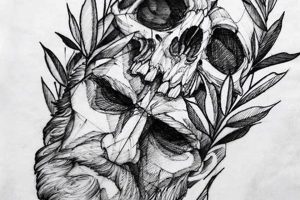Tattoos applied to the leg offer a large, versatile canvas for artistic expression, ranging from small, minimalist designs to elaborate, full-leg pieces. Examples include floral motifs, geometric patterns, portraits, and depictions of animals or mythological creatures. The placement options further diversify the possibilities, with designs adaptable to the thigh, calf, ankle, or foot.
Leg tattoos provide a unique blend of visibility and concealability. They can be easily displayed or covered depending on personal preference and social context. This adaptability makes them a popular choice for individuals seeking self-expression through body art. Historically, leg tattoos have held cultural significance in various societies, representing status, beliefs, or group affiliation. Today, they continue to serve as a powerful medium for personal storytelling and aesthetic enhancement.
Exploring design options, placement considerations, and aftercare practices provides crucial information for those contemplating this form of body art. Understanding the healing process, potential risks, and the importance of selecting a reputable artist are also key factors contributing to a positive and successful tattoo experience.
1. Placement (thigh, calf, ankle)
Strategic placement is paramount in leg tattoo design, influencing the overall aesthetic, visibility, and how the design interacts with the body’s natural contours. Careful consideration of these areasthigh, calf, and ankleensures a cohesive and visually appealing result.
- Thigh
The thigh offers the largest canvas on the leg, accommodating expansive, detailed designs. Its relatively flat surface lends itself well to intricate patterns, portraits, and scenes. Thigh tattoos can be easily concealed or prominently displayed, providing versatility for various social settings. The outer thigh generally presents a less painful experience compared to the inner thigh due to muscle density and nerve distribution.
- Calf
The calf’s muscular shape provides a dynamic canvas for designs that wrap around the leg. Its curvature can be accentuated with skillfully applied artwork, creating a three-dimensional effect. Calf tattoos offer a balance between visibility and concealability, suitable for those seeking a prominent yet adaptable tattoo. The pain level is generally moderate, varying based on individual sensitivity and design placement.
- Ankle
The ankle presents a smaller, more delicate canvas, ideal for minimalist designs, small symbols, or text. Its visibility makes it a popular choice for those who desire a subtle yet noticeable tattoo. Due to the proximity of bone and thinner skin, ankle tattoos can be more sensitive than those on the thigh or calf. The intricate nature of ankle bones allows for designs that can elegantly wrap around or accentuate this area.
- Foot
While not explicitly part of the leg, the foot’s proximity and visual connection make it a relevant consideration. Small, intricate designs, often placed on the top of the foot or along the sides, are common. Foot tattoos offer a unique aesthetic but require careful consideration due to increased sensitivity and potential healing challenges associated with this area.
Placement decisions ultimately depend on individual preferences, pain tolerance, and the desired visual impact. A comprehensive understanding of these anatomical areas empowers individuals to select the optimal location to showcase their chosen design effectively.
2. Size and scale
Size and scale are fundamental considerations in leg tattoo design, significantly impacting the visual impact, detail level, and overall aesthetic. Harmonizing these elements with the chosen imagery and the leg’s anatomy is crucial for a successful tattoo.
- Small-scale designs
Small tattoos offer subtlety and precision, ideal for minimalist imagery, symbols, or text. They can be strategically placed on the ankle, foot, or even incorporated into larger compositions. Examples include delicate floral motifs, geometric patterns, or single-word inscriptions. Their compact nature allows for greater flexibility in placement and often results in shorter tattooing sessions.
- Medium-scale designs
Medium-sized tattoos offer a balance between detail and impact. They are well-suited for moderately complex imagery, such as portraits, animal depictions, or intricate patterns. Common placements include the calf or thigh. Medium-scale designs allow for a greater level of detail than smaller tattoos while maintaining a manageable size and session duration.
- Large-scale designs
Large-scale tattoos command attention and provide ample space for intricate details, expansive scenes, or combinations of multiple elements. They often utilize the entire thigh or calf as a canvas, creating visually striking body art. Examples include full-leg sleeves, elaborate murals, or interconnected designs that flow across multiple areas. Large-scale projects require significant planning, multiple sessions, and a higher pain tolerance.
- Proportion and placement
Proportion refers to the relationship between the tattoo’s size and the surrounding area of the leg. A well-proportioned tattoo complements the body’s natural contours and avoids appearing disproportionately large or small. Placement further influences the perceived size and scale, with tattoos placed on the ankle generally appearing smaller than those on the thigh, even if their actual dimensions are similar. Careful consideration of proportion and placement ensures a harmonious and visually balanced outcome.
The interplay between size and scale significantly contributes to the overall aesthetic of a leg tattoo. By carefully considering these factors in relation to design complexity, placement, and personal preferences, individuals can achieve a visually compelling and personally meaningful result. Proper planning and consultation with a skilled tattoo artist are crucial for selecting the appropriate size and scale to effectively realize the desired artistic vision.
3. Style and imagery
Style and imagery are integral to leg tattoo design, profoundly influencing the final aesthetic and conveying personal narratives. A wide array of styles and imagery allows for diverse expressions of individuality, beliefs, and artistic preferences. Selecting a style that resonates with personal aesthetics and complements the chosen imagery is crucial for a successful and meaningful tattoo.
- Realism
Realistic tattoos strive to replicate the appearance of photographs or real-life objects. This style demands technical skill and precision, capturing intricate details and subtle nuances. Realistic portraits, animal depictions, or natural scenes are common examples. In the context of leg tattoos, realism can create visually striking pieces, especially on the larger canvas of the thigh or calf.
- Traditional
Traditional tattooing, often referred to as American Traditional or Old School, features bold lines, vibrant colors, and iconic imagery such as anchors, roses, and skulls. This style has a rich history and distinct aesthetic, often conveying symbolic meanings. On the leg, traditional tattoos can create a bold statement, particularly when adapted to the calf’s curvature or placed prominently on the thigh.
- Japanese
Japanese tattooing, or Irezumi, is characterized by its intricate detail, vibrant colors, and flowing compositions often featuring mythical creatures, flowers, and waves. This style carries cultural significance and often incorporates symbolic elements. Large-scale Japanese designs can be particularly impactful on the leg, utilizing the expansive canvas to showcase intricate details and dynamic imagery.
- Geometric
Geometric tattoos utilize precise lines and shapes to create abstract or symmetrical patterns. This style often incorporates mathematical concepts and can range from minimalist designs to complex, interconnected patterns. Geometric tattoos can be adapted to various sizes and placements on the leg, offering a contemporary and visually appealing aesthetic.
The interplay between style and imagery is fundamental to realizing a successful leg tattoo. By carefully considering these elements and their relationship to personal aesthetics and desired message, individuals can create a piece of body art that is both visually striking and deeply meaningful. Consultation with a skilled tattoo artist experienced in the chosen style is crucial for ensuring a high-quality and aesthetically pleasing result.
4. Color palettes
Color palettes significantly influence the aesthetic impact and overall impression of leg tattoos. Careful selection of colors contributes to the design’s mood, visual depth, and longevity. Understanding the interplay of colors, skin tone, and tattoo placement is essential for achieving desired results.
Monochromatic palettes, utilizing variations of a single color, create a cohesive and classic look. Black and grey realism, for example, relies on shading and contrast to achieve depth and detail. Limited color palettes, using two to three colors, offer a balanced approach, allowing for subtle accents while maintaining a unified aesthetic. A traditional Japanese tattoo might incorporate red, black, and gold for a bold yet harmonious effect. Full-color palettes provide the greatest range of artistic expression, allowing for vibrant, complex designs. However, certain colors, particularly lighter shades, may fade more quickly, requiring touch-ups over time. Skin tone plays a crucial role in color selection; darker skin tones may require bolder colors to achieve the desired vibrancy, while lighter skin tones offer greater flexibility.
Choosing an appropriate color palette requires consideration of the tattoo’s style, subject matter, and placement. Consulting with a skilled tattoo artist is crucial for selecting colors that complement the design, skin tone, and ensure long-lasting vibrancy. Understanding the properties of different pigments and their interaction with light and skin is essential for achieving a visually appealing and durable tattoo.
5. Pain Tolerance
Pain tolerance is a crucial factor to consider when planning a leg tattoo. The leg encompasses areas with varying levels of sensitivity, influencing the overall experience. Understanding the relationship between pain, placement, and design complexity allows for informed decisions and realistic expectations. Areas near bone, such as the ankle, knee, and shin, tend to be more sensitive due to thinner skin and increased nerve density. The inner thigh also ranks high on the pain scale due to sensitive skin and nerve endings. The outer thigh and calf generally offer a less painful experience due to more muscle and fat cushioning. Larger, more intricate designs require longer sessions, increasing the overall discomfort regardless of placement. Individual pain thresholds vary significantly; what one person finds tolerable, another might find challenging.
Effective pain management strategies can significantly improve the tattooing experience. These strategies include proper rest and hydration before the appointment, avoiding alcohol and caffeine which can thin the blood and increase sensitivity, and communicating openly with the tattoo artist about any discomfort during the session. Topical numbing creams can also offer some relief, though their effectiveness varies. Mental preparation, such as deep breathing exercises or meditation, can also assist in managing pain and anxiety. Breaking larger tattoo projects into multiple sessions allows for breaks and reduces prolonged discomfort.
While pain is an inherent aspect of the tattooing process, understanding anatomical variations in sensitivity and implementing appropriate pain management techniques can greatly improve the overall experience. Realistic expectations regarding pain levels, combined with open communication with the tattoo artist, contribute to a more positive and manageable outcome, allowing individuals to focus on the artistic process rather than solely on discomfort. This understanding empowers informed decisions regarding placement, size, and design complexity, ultimately contributing to a more satisfying and successful leg tattoo experience.
Tips for Leg Tattoo Ideas
Careful planning is essential for a successful leg tattoo. These tips offer guidance for navigating the process, from concept to aftercare.
Tip 1: Research Artists Thoroughly:
Seek artists specializing in the desired style. Review portfolios, testimonials, and hygiene practices. A skilled artist contributes significantly to the tattoo’s quality and longevity.
Tip 2: Consider Placement Carefully:
Different areas of the leg offer varying levels of visibility, pain, and suitability for certain designs. Thighs accommodate larger pieces, calves suit wrap-around designs, and ankles are ideal for smaller, delicate work. Consider lifestyle and clothing choices when selecting placement.
Tip 3: Design with Anatomy in Mind:
The leg’s musculature and contours can enhance or detract from a tattoo. Work with the artist to create a design that complements the body’s natural shape and flow.
Tip 4: Plan for Long Sessions:
Larger, more detailed tattoos often require multiple sessions. Be prepared for the time commitment and associated costs. Schedule breaks during sessions to manage discomfort.
Tip 5: Prioritize Aftercare:
Proper aftercare is crucial for healing and preserving the tattoo’s vibrancy. Follow the artist’s instructions diligently regarding cleaning, moisturizing, and sun protection. Avoid tight clothing and submerging the tattoo in water during the healing period.
Tip 6: Budget Accordingly:
High-quality tattoos represent an investment. Research pricing structures and factor in potential touch-up costs. Avoid compromising quality for cost; a well-executed tattoo is a lasting piece of art.
Tip 7: Think Long-Term:
Tattoos are permanent. Consider the design’s relevance and meaning over time. Avoid impulsive decisions based on trends or fleeting interests. A well-chosen design will remain personally meaningful for years to come.
By following these guidelines, individuals can navigate the process of obtaining a leg tattoo with greater confidence, ensuring a result that is both aesthetically pleasing and personally meaningful. Careful planning and consideration of these factors contribute significantly to a positive and successful tattoo experience.
The journey of acquiring a leg tattoo extends beyond the initial design and application. Understanding the long-term commitment and ongoing care ensures the tattoo remains a source of personal pride and artistic expression for years to come.
Frequently Asked Questions about Leg Tattoos
This section addresses common inquiries regarding leg tattoos, offering factual information and practical guidance for those considering this form of body art.
Question 1: How much do leg tattoos typically cost?
Costs vary based on size, complexity, artist’s experience, and studio location. Small, simple designs may cost a few hundred dollars, while larger, more intricate pieces can range into thousands. Consulting with a prospective artist provides accurate pricing based on individual design specifications.
Question 2: How long does a leg tattoo take to heal?
Healing time typically ranges from two to four weeks, depending on size, placement, and individual healing rates. Proper aftercare significantly influences healing time and minimizes potential complications.
Question 3: Are leg tattoos more painful than other locations?
Pain levels vary depending on individual pain thresholds and specific locations on the leg. Areas near bone, such as the ankle or shin, tend to be more sensitive. The inner thigh is also considered a more sensitive area. The outer thigh and calf generally offer a less painful experience.
Question 4: What are the best aftercare practices for leg tattoos?
Essential aftercare practices include keeping the tattoo clean and moisturized, avoiding direct sunlight, and refraining from submerging the tattoo in water for an extended period during the healing process. Following the artist’s specific aftercare instructions is crucial for optimal healing and color retention.
Question 5: Can leg tattoos be covered up easily?
Leg tattoos offer a balance of visibility and concealability. They can be easily covered with clothing when desired, making them a versatile option for those navigating professional or social settings with varying dress codes.
Question 6: How do I choose the right tattoo artist for my leg tattoo?
Thorough research is crucial when selecting a tattoo artist. Review portfolios, seek recommendations, and schedule consultations to discuss design ideas and assess the artist’s style, experience, and hygiene practices. Choosing an artist specializing in the desired style ensures a high-quality and satisfying result.
Addressing these common questions provides a foundational understanding of the factors involved in obtaining a leg tattoo. Thorough research, careful planning, and open communication with a qualified artist are essential for a successful and positive experience.
Further exploration of specific design styles, imagery, and placement options will enable individuals to create a personalized leg tattoo that reflects their unique aesthetic and personal narrative.
Leg Tattoo Ideas
Exploration of leg tattoo ideas reveals a diverse range of artistic possibilities, encompassing various styles, sizes, placements, and color palettes. Careful consideration of design elements in relation to the leg’s anatomy is crucial for achieving aesthetically pleasing and personally meaningful results. Placement decisions impact visibility and how the design interacts with the body’s natural contours. Size and scale should complement the chosen imagery and available canvas. Style considerations range from realism to abstract or geometric patterns, each offering unique aesthetic qualities. Color palettes contribute significantly to the visual impact and longevity of the tattoo. Pain tolerance, a practical consideration, influences design complexity and session duration, particularly in sensitive areas.
Ultimately, successful leg tattoos represent a confluence of artistic vision, technical skill, and informed decision-making. Thorough research, consultation with experienced artists, and diligent aftercare practices are essential for realizing a high-quality, enduring piece of body art. The enduring power of leg tattoos lies in their capacity for personal expression, allowing individuals to showcase their unique narratives and aesthetic preferences through a dynamic and versatile art form.







